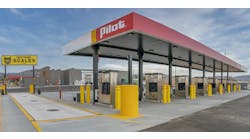Field test results promising for Cummins ultra-low carbon fuel powertrain
Knight Transportation, Inc. has been testing Cummins’ new X15N natural gas engine in Southern California, and seeing reductions in NOx and greenhouse gas without compromise to performance, the company said in a joint press release along with Cummins and Clean Energy Fuels Corp.
Cummins' X15N natural gas engine, expected to hit the market in 2024, delivers diesel-like ratings while allowing fleets to significantly reduce their carbon footprint by running on renewable natural gas without sacrificing capability, the release says.
See also: Shell Starship 2.0 transitioning to natural gas
“Our customers rely on us to deliver a wide range of loads critical to their businesses,” said Dave Williams, Knight-Swift Transportation’s Senior Vice President of Equipment and Government Relations. “We must ensure we are utilizing the most reliable and efficient technologies possible that help us reduce our carbon footprint."
The truck is fueled exclusively with Clean Energy ultra-low carbon Renewable Natural Gas (RNG) anchored by Clean Energy’s station in Carson, California.
Clean Energy creates negative carbon intensity RNG by trapping methane at its biogenic source, preventing it from escaping into the atmosphere, and turning it into transportation grade renewable fuel that's then supplied to Clean Energy stations throughout California, according to Clean Energy Vice President Derek Turbide.
See also: A look at Cummins' journey toward zero-emissions future
"The suite of integrated Cummins technologies used on these trucks from engine, aftertreatment, and fuel storage to transmission, axles and the digital features that pull them all together in their most optimized form demonstrates the value of our next generation of product to our customers,” said José Samperio, Vice President North American On-Highway Business, Cummins Inc.
Knight-Swift says its field testing will continue through full production of the X15N powertrain in 2024. The Phoenix, Arizona-based company’s goal is to reduce CO2 emissions generated from the KNX fleet by 50% by 2035.




